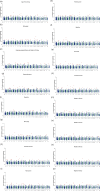Applying the algorithm for Proven and young in GWAS Reveals high polygenicity for key traits in Nellore cattle
- PMID: 40370699
- PMCID: PMC12075139
- DOI: 10.3389/fgene.2025.1549284
Applying the algorithm for Proven and young in GWAS Reveals high polygenicity for key traits in Nellore cattle
Abstract
Background: Identifying genomic regions associated with traits of interest and their biological processes provides valuable insights into the phenotypic variability of these traits. This study aimed to identify candidate genes and genomic regions associated with 16 traits currently evaluated by the Brazilian Association of Zebu Breeders (ABCZ). These traits include reproductive traits such as age at first calving (AFC), stayability (STAY), and scrotal circumference at 365 (SC365) and 450 days (SC450). Growth traits include birthweight (BW), expected progeny difference for weight at 120days of age (EPD120), as well as weight at 120 (W120), 210 (W210), 365 (W365), and 450 days of age (W450). Carcass traits include body conformation (BC), finishing score (FS), marbling (MARB), muscularity (MUSC), finishing precocity (FP), and ribeye area (REA).
Methods: A dataset containing 304,782 Nellore cattle genotyped with 437,650 SNPs (after quality control) was used for this study. The Algorithm for Proven and Young (APY), implemented in the PREGSF90 software, was used to compute the matrix using 36,000 core animals (which explained 98% of the variance in the genomic matrix). Subsequently, the SNP solutions were estimated by back-solving the Genomic Estimated Breeding Values (GEBVs) predicted by ABCZ using the single-step GBLUP method. Genomic regions were identified using sliding windows of 175 consecutive SNPs, and the top 1% genomic windows, ranked based on their proportion of the additive genetic variance, were used to annotate positional candidate genes and genomic regions associated with each of the 16 traits.
Results: The top 1% windows for all traits explained between 2.779% (STAY) to 3.158% (FP) of the additive genetic variance, highlighting the polygenic nature of these traits. Functional analysis of the candidate genes and genomic regions provided valuable insights into the genetic architecture underlying these traits in Nellore cattle. For instance, our results revealed genes with important functions for each trait, such as SERPINA14 (plays a key role for the endometrial epithelium) identified for AFC, HSPG2 (associated with morphological development and tissue differentiation) identified for BW, among others.
Conclusion: We identified genomic regions and candidate genes, some of which have been previously reported in the literature, while others are novel discoveries that warrant further investigation. These findings contribute to gene prioritization efforts, facilitating the identification of functional candidate genes that can enhance genomic selection strategies for economically important traits in Nellore cattle.
Keywords: GWAS; candidate genes; genomic estimated breeding value; genomic regions; single step.
Copyright © 2025 Ogunbawo, Hidalgo, Mulim, Carrara, Ventura, Souza, Lourenco and Oliveira.
Conflict of interest statement
The authors declare that the research was conducted in the absence of any commercial or financial relationships that could be construed as a potential conflict of interest.
Figures
Similar articles
-
Heritability and genetic correlations between marbling in longissimus dorsi muscle and conventional economic traits in Nellore beef cattle.Trop Anim Health Prod. 2022 Sep 7;54(5):274. doi: 10.1007/s11250-022-03293-6. Trop Anim Health Prod. 2022. PMID: 36068366
-
Genome scan for postmortem carcass traits in Nellore cattle.J Anim Sci. 2016 Oct;94(10):4087-4095. doi: 10.2527/jas.2016-0632. J Anim Sci. 2016. PMID: 27898882
-
Genetic Parameter Estimates for Carcass and Meat Quality Traits and Their Genetic Associations With Sexual Precocity Indicator Traits in Nellore Cattle.J Anim Breed Genet. 2025 Feb 5. doi: 10.1111/jbg.12927. Online ahead of print. J Anim Breed Genet. 2025. PMID: 39907255
-
Genetic associations between carcass traits measured by real-time ultrasound and scrotal circumference and growth traits in Nelore cattle.J Anim Sci. 2010 Jan;88(1):52-8. doi: 10.2527/jas.2008-1028. Epub 2009 Oct 9. J Anim Sci. 2010. PMID: 19820065
-
Exploring and Identifying Candidate Genes and Genomic Regions Related to Economically Important Traits in Hanwoo Cattle.Curr Issues Mol Biol. 2022 Dec 4;44(12):6075-6092. doi: 10.3390/cimb44120414. Curr Issues Mol Biol. 2022. PMID: 36547075 Free PMC article. Review.
Cited by
-
Genomic Analysis of Reproductive Trait Divergence in Duroc and Yorkshire Pigs: A Comparison of Mixed Models and Selective Sweep Detection.Vet Sci. 2025 Jul 11;12(7):657. doi: 10.3390/vetsci12070657. Vet Sci. 2025. PMID: 40711316 Free PMC article.
References
-
- ABCZ (2024). History of ABCZ. Available online at: https://www.abcz.org.br/a-abcz/historia (Accessed November 2, 2024).
-
- Albuquerque L., Fernandes Júnior G., Carvalheiro R. (2018). Beef cattle genomic selection in Tropical environments.
LinkOut - more resources
Full Text Sources


